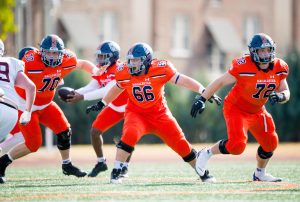Accessibility at Mac or Lack Thereof

February 2, 2023
As the ripple effects of the COVID-19 pandemic continue to impact our society, disability becomes increasingly present in our daily lives. With an estimated 30% of COVID survivors expected to experience long term effects, and the way in which emotional and mental health issues seem to have increased by 25.2% since the onset of the COVID-19 pandemic, more students than ever are becoming physically and mentally disabled. Colleges have pushed for a return to “normal,” but we must stop and seek out a better world in light of all the lessons learned over the past few years. Macalester’s statement of purpose says they seek to help students achieve learning “through an environment that values the diverse cultures of our world and recognizes our responsibility to provide a supportive and respectful environment for students, staff and faculty of all cultures and backgrounds.” Despite this, our campus distinctly lacks physical accessibility. In light of the increasing number of disabled students coming to college, our community must direct our attention to disability studies, justice, and accessibility for all.
Disabled people have historically been and continue to be underrepresented in higher education, which means that the issue of disability is often not considered by most of the non-disabled student body. One key way to change this is to remember that intersectionality includes disabled individuals and makes discrimination increase with each marginalized identity an individual holds. Another part of the solution is to increase representation in higher education. When this occurs, bias and discrimination has been observed to decrease. Disabled individuals face increased challenges to access basic necessities compared to the rest of the population. Considering these challenges combined with years of prejudice, it is more important than ever that we foster a community of care and ensure that all perspectives are heard on our campus. Without an accessible environment, how can we expect disabled individuals to be eager to attend Macalester? This piece of the Macalester experience is not only a barrier, but could discourage disabled people from attending entirely.
Across campus there are examples of access, rather than inclusive and universal design. Think about how you get to your dorm, classes or even the laundry room. For most, these destinations involve at least one stair. Now imagine if you were not able to take those stairs—how much harder would it be to get to class? Once you start looking, you won’t be able to miss just how many buildings are technically accessible, yet still force disabled students to go out of their way to access the same room as others. Macalester is lacking in universal design, meaning that disabled students are forced to take alternate routes which take up more time and serve to physically separate them from other students.
Accessible architecture does not have to mean making new buildings. While architecture is still working to integrate inclusive design, Macalester’s Comprehensive Campus plan is one opportunity where community members can have their voice heard as new designs for campus develop. There are other opportunities to speak out on campus as well, such as Radical MacACCESS, though the movement is small. A truly inclusive campus layout could manifest in many ways, but creating walkways and entries which are usable by all is a first step.
However, the push to achieve inclusive architecture on our campus needs support from all community members. This lack of consideration for physically disabled members of our community sends the message that the school does not care about prioritizing disabled individuals. Disabled people and issues are hidden away, both in how we talk and in our built environment. Student pushback against ableism at Macalester is largely forgotten, leaving current community members without an established network of support. We have to fight to increase not only accessibility of our physical spaces, but also campus-wide disabled representation. From targeted hiring practices, to creating a disability cultural center, to making our academics more aware of disability justice issues, there is so much Macalester and its community can do. A truly inclusive campus may be hard to imagine; partly because it really hasn’t been done before. It will require concerted efforts from many different people: architects, students, administrators, faculty. The entire community plays a role in crafting a better future. Whatever your relationship with disability, the lack of inclusion is a loss to us all.
This may sound daunting. It is, after all, a massive systemic issue with Macalester and our broader society. However, the path to a better future doesn’t have to be scary. It can start with you talking about disability. It could be using a lens of intersectionality when writing a paper. Or, you could take up organizing and protesting. An individual can do many things to help work towards disability justice, and the hardest step is the first. Go away with a new perspective, a critical gaze which prioritizes disabled justice. Start looking at what is going on around you. Share these ideas with friends. Organize! Together, we can bring a future of true access for all just that much closer to the present.
References:
Anon. 2019. “Mission and History.” About – At Macalester College, We’re Painting a Different Picture of What a Liberal Arts Education Can Be—One Where Challenging Academics Inspire Personal, Social, and Intellectual Growth. Retrieved December 6, 2022 (https://www.macalester.edu/about/mission/).
Anon. n.d. “What Is the Difference between Accessible, Usable, and Universal Design? | DO-IT.” Retrieved December 6, 2022 (https://www.washington.edu/doit/what-difference-between-accessible-usable-and-universal-design).
CDC. 2022. “Disability Impacts All of Us Infographic | CDC.” Centers for Disease Control and Prevention. Retrieved December 6, 2022 (https://www.cdc.gov/ncbddd/disabilityandhealth/infographic-disability-impacts-all.html).
Chihak, Bea. n.d. “Narratives of Disability Activism at Macalester College, 1907 to the 1990s.” 81.
Fan, Y., L. J. Shepherd, E. Slavich, D. Waters, M. Stone, R. Abel, and E. L. Johnston. 2019. “Gender and Cultural Bias in Student Evaluations: Why Representation Matters.” PLOS ONE 14(2):e0209749. doi: 10.1371/journal.pone.0209749.
Linden, Valerie Van der, Hua Dong, and Ann Heylighen. 2016. “From Accessibility to Experience: Opportunities for Inclusive Design in Architectural Practice.” NA 28(2).
Mazer, Benjamin. 2022. “Long COVID Could Be a ‘Mass Deterioration Event.’” The Atlantic. Retrieved December 6, 2022 (https://www.theatlantic.com/health/archive/2022/06/long-covid-chronic-illness-disability/661285/).
Michalski, Joseph H., Tracy Cunningham, and Joe Henry. 2017. “The Diversity Challenge for Higher Education in Canada: The Prospects and Challenges of Increased Access and Student Success.” Humboldt Journal of Social Relations 39:66–89.
https://jamanetwork.com/journals/jamapediatrics/fullarticle/2782796











